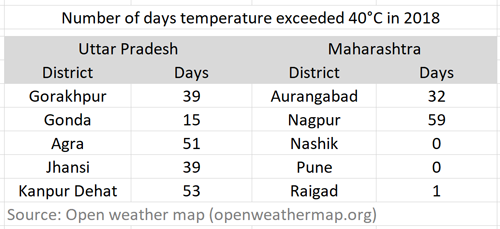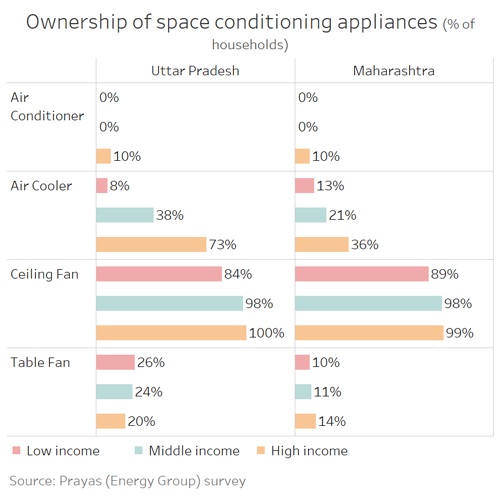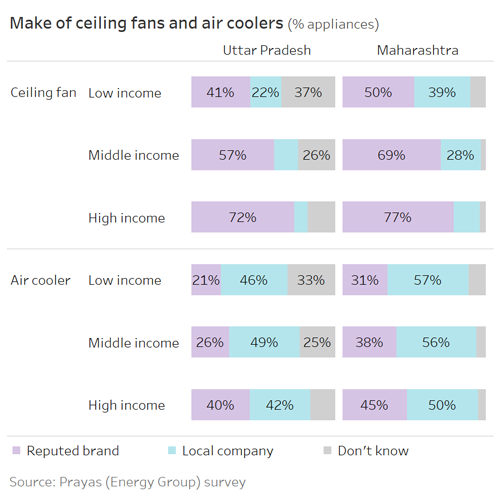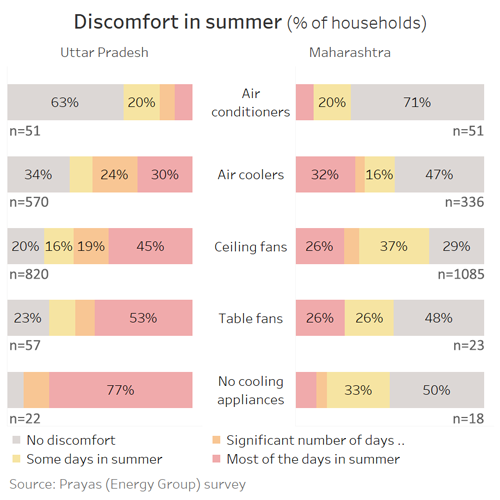Prayas (Energy Group) conducted a survey of 3000 households in semi-urban and rural areas of Uttar Pradesh and Maharashtra to understand their energy end-use patterns. This survey was conducted in February-March 2019. ECHO is a series of blog posts presenting the key findings of the survey. This post discusses households’ use of electricity for space-conditioning.
Sampling plan and household categorization are briefly described here.
India’s climate varies substantially across regions and seasons. However, most of the country experiences hot summers which are getting hotter. About 50 million fans, 8 million air-coolers, and 4.5 million air-conditioners are bought annually. Their sales have grown steadily over the last few years and are expected to increase. However, the household ownership of air-coolers and air-conditioners is still low in India. India is one of the few countries to have developed a cooling action plan with a goal to provide sustainable cooling and thermal comfort for all while securing environmental and socio-economic benefits for the society. How do the surveyed households seek comfort from heat and what insights it may have for the policies/programmes aimed at influencing the energy demand for cooling in India?
Uttar Pradesh is usually hotter than Maharashtra. In 2018, the number of days where the maximum temperature exceeded 40 degrees Celsius was significantly more in the surveyed districts of Uttar Pradesh than in Maharashtra (see Table 1). Although the winters are cold, particularly in Uttar Pradesh, the ownership of electric room heaters is negligible in both states. Hence, we focus only on the use of electricity by households to seek relief from the heat.

Table 1: Number of days in 2018 with maximum temperature exceeding 40 degrees Celsius
Ceiling fan is the most commonly used appliance (see Figure 1). About 94% of the surveyed households in Uttar Pradesh and 95% in Maharashtra own ceiling fans. There are about 2.4 ceiling fans per household in Uttar Pradesh and 1.6 in Maharashtra. It is also observed that houses in Uttar Pradesh are larger (average 3.8 rooms) than Maharashtra (average 2.8 rooms). The next popular appliance is air-cooler with 40% ownership in Uttar Pradesh and 23% in Maharashtra. Although the ownership is higher in high income households some low and medium income households also own air-coolers. This suggests availability of cheaper locally made air-coolers. Ownership of air-conditioners on the other hand is very low in both states at about 3.5% and as one would expect mostly in the higher income category. Majority of the air-conditioners are split-type; 84% in Uttar Pradesh and 70% in Maharashtra. The average age of the most used appliance in each category was reported to be 7 years for ceiling fans, 4 for air-coolers, and 2.5 for air-conditioners in Uttar Pradesh and 7, 5, 3 in Maharashtra respectively.

Figure 1: Ownership of space-conditioning appliances in surveyed households
Bureau of Energy Efficiency (BEE)’s standards and labelling (S&L) programme is voluntary for ceiling fans. More than 95% of the ceiling fans produced in India are not star-rated. In our sample, about 6% of households in Uttar Pradesh and 18% of households in Maharashtra reported having star-rated ceiling fans. BEE recently revised the standards and the new 5-star ceiling fan consumes half as much electricity as compared to a non star-rated fan. Awareness, affordability, and availability of star-rated ceiling fans must increase to facilitate their wide-scale adoption. BEE can conduct national level campaigns to increase awareness about star-rated fans. BEE can also make the S&L programme mandatory for all the ceiling fans so that inefficient non star rated fans cannot be sold in India. Energy Efficiency Services Ltd. (EESL)’s UJALA programme sells 5-star fans at discounted price. EESL can upgrade the programme to sell new 5-star fans which are 30% more efficient than the old 5-star fans. BEE can support the UJALA programme with its own Super-Efficient Equipment Programme (SEEP) under which time-bound financial incentives were to be provided to manufacturers to cover incremental cost of producing super-efficient fans (the new 5-star fans) over normal fans. This can further bring down the price of these fans and increase its uptake. A similar approach can be taken for air-coolers. Unlike ceiling fans, BEE does not have a star-rating programme for air-coolers. The first step would be to include air-coolers in the star-rating programme, and then launch an UJALA kind of programme.
One challenge for the star-rating programme for ceiling fans and air-coolers can be the presence of local manufacturers. Some of them may sell cheap, non-standard, and highly inefficient models. BEE can find it difficult to monitor the compliance of these products with the star-rating norms. The problem is more pronounced in air-coolers. The share of surveyed households owning local-make air-coolers is much higher than that of ceiling fans (see Figure 2) in both the states. Addressing this issue will be crucial to the success of the star-rating programme for both air-coolers and fans.

Figure 2: Make of ceiling fans and air-coolers.
The ownership of air-conditioners in the surveyed households is low in both the states (see Figure 1). However, some observations can be made about their usage from the survey. BEE has a mandatory S&L programme for air-conditioners. About 34% of households with air-conditioners in both the states reported owning efficient 4 and 5 star rated models. About 49% of households in Uttar Pradesh and 32% in Maharashtra either did not know about the star-labels or reported owning a non star rated model indicating a lower awareness about the programme even for the air-conditioners. Households report an average temperature setting of 21 degrees Celsius (standard deviation = 3.3) in Uttar Pradesh and 22 degrees Celsius (standard deviation = 2.9) in Maharashtra. This indicates that making default setting to 24 degrees Celsius as recommended by BEE recently can nudge consumers to set the temperatures higher and save electricity. On the other hand, the usage of air-conditioners is quite low. The average usage of air-conditioner on a typical summer day is 3.8 hours (standard deviation = 3.0) in Uttar Pradesh and 4.5 hours (standard deviation = 2.6) in Maharashtra. It is quite possible that people set lower temperature in the air-conditioners and then switch it off after the room has been cooled. This also suggests a higher possibility of rebound effect where consumers can end up using air-conditioners for longer duration if they become more efficient. However, this needs to be investigated further.
We also asked the households whether they faced any discomfort in summer even after using the appliances they own. About 59% of the surveyed households in Uttar Pradesh and 34% in Maharashtra reported facing discomfort for significant or most of the days in summer. We further segregated the households based on their ownership of space-conditioning appliances and compared their discomfort levels as shown in Figure 3. In the figure, households owning one category of appliances may own all the appliances listed below it which means households owning an air-conditioner may own either one or all of air-cooler, ceiling fan and table fan and so on. In Uttar Pradesh, the share of households facing discomfort reduces as people move from table fans to air-conditioners. However, the trend is not so clear in Maharashtra. One possible reason maybe the higher intensity of summers in the surveyed districts of Uttar Pradesh. Interestingly, there are about 10% of households in both states who own an air-conditioner but still face discomfort for most of the days in summer. This may be because of limited use of the air-conditioners either because of high electricity bills or frequent power outages or both. It may also be due to the incorrect sizing of the air-conditioners which may result in insufficient cooling.

Figure 3: Discomfort in Summer
Higher levels of discomfort in the households coupled with the trend of increasing temperatures suggest a potential demand for all the space-conditioning appliances. Interventions are required to ensure that these appliances are energy efficient to meet the cooling needs in a sustainable and affordable manner. Policies like standards and labelling (S&L) and programmes similar to UJALA supported by Super-Efficient Equipment Programme (SEEP) will play a crucial role in achieving this goal.
In the next post, we will discuss the use of refrigerator and other appliances like mixer-blender, television, and water pump.
Please contact Aditya Chunekar (
Click here to access other posts in the blog
This post was translated and published by Eklavya in their Hindi magazine Srot (Vigyan evam technology features). This translation is available here.


